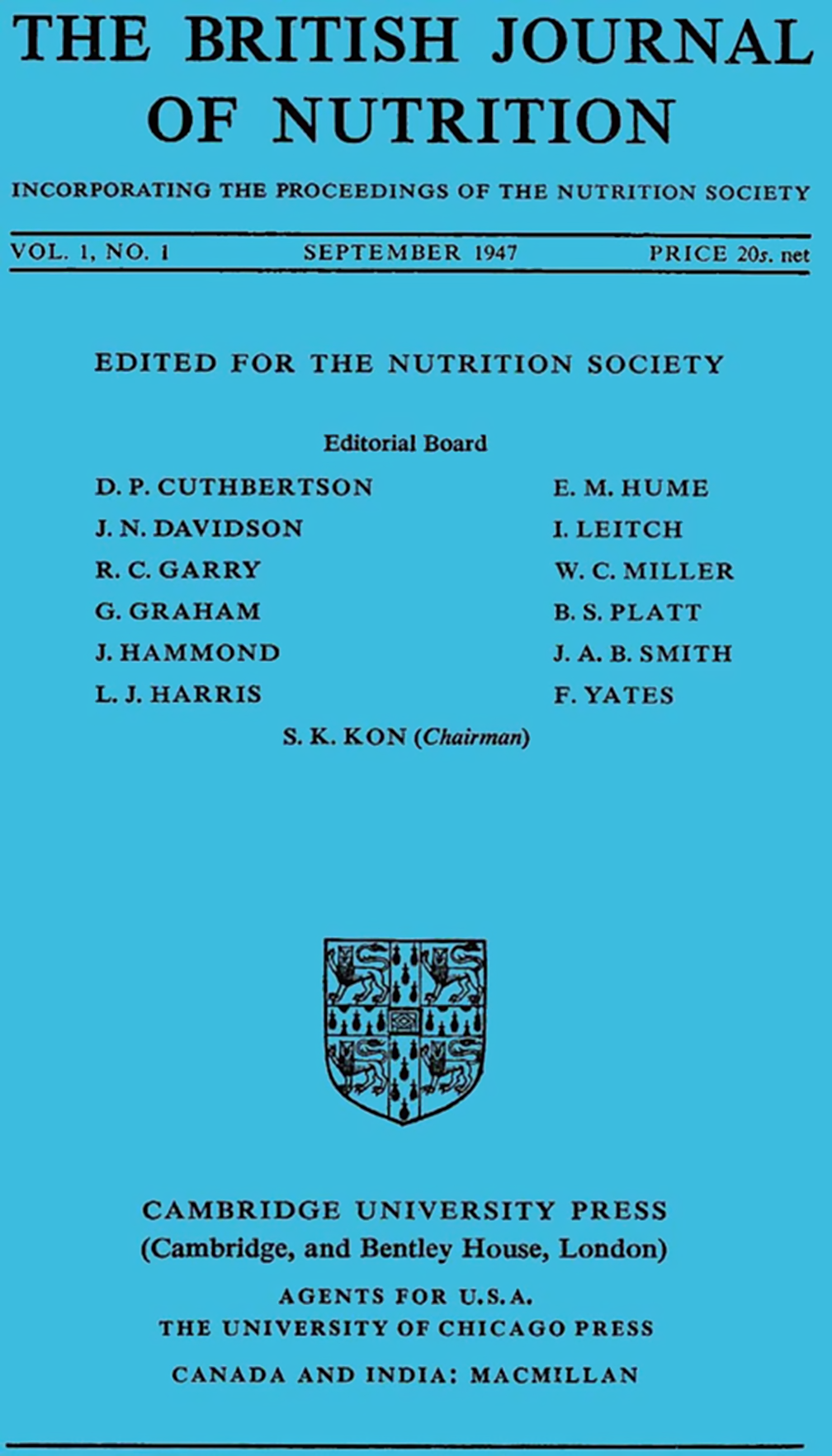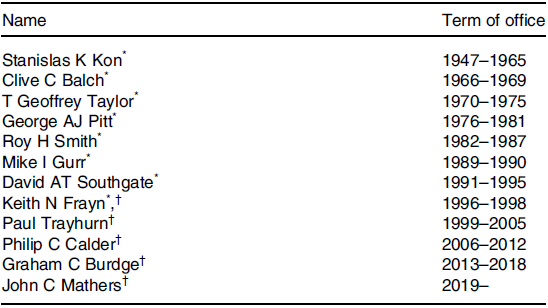How it started
The first Scientific Meeting of the Nutrition Society was held on 18 October 1941 and notes of the event were recorded in a small 20-page document entitled ‘Proceedings of the Nutrition Society No. I. (1942)’. For the next few years, the Society continued to publish reports of its scientific meetings in the Proceedings. However, in 1944, the editors of the Lancet and the British Medical Journal, amongst others, suggested that the Society should consider publishing its own journal containing original papers in nutrition research. Subsequently, Council of the Nutrition Society agreed to launch the British Journal of Nutrition. With advice and support from our publishing partners Cambridge University Press, the BJN began publishing scientific papers on nutritional topics in September 1947 (Fig. 1).

Fig. 1. Front cover of the first issue of the British Journal of Nutrition.
From the outset, the BJN had a strong focus on methodological rigour and, indeed, the first research paper in the first issue addressed the question of how to quantify ascorbic acid (vitamin C) in foods in the presence of ‘interfering substances’(Reference Harris and Mapson1). At first, the BJN also included reports of the Society’s scientific conferences but, by 1952, it was clear that the BJN’s growing reputation meant it could attract plenty of papers and a decision was taken to publish the Proceedings of the Nutrition Society as a separate journal.
The remarkable Stanislas K Kon was BJN’s first Editor-in-Chief (then styled Chairman of the Editorial Board) who held the post from 1947 to 1965; he was also, by far, the longest-serving Editor-in-Chief. His obituary, published in the BJN in 1987, remarked on his ‘… passionate demand for accuracy and his insistence on clarity of expression…. His editorship set the pattern for the high standards the Journal maintains today’. The BJN continues to enjoy a high reputation for the rigour and fairness of our review process. Each of the Editors-in-Chief who succeeded Kon (Table 1) stood on the shoulders of a giant. Each made important contributions to the growth and development of our journal. In our 75th Anniversary year, I am delighted to celebrate their achievements and to record my thanks for the excellent work done by all Editorial Board members, by the anonymous peer reviewers, by our editorial staff and by our publishers.
Table 1. Editors-in-Chief of the British Journal of Nutrition

* Chairman of the Editorial Board.
† Editor-in-Chief.
Celebrating excellence in nutrition research
As part of our 75th Anniversary celebrations, we have prepared a Special Collection on the BJN website of some of our most highly cited articles (https://www.cambridge.org/core/journals/british-journal-of-nutrition/british-journal-of-nutrition-75th-anniversary-collection). In parallel, over the next 6 months, we will publish a series of Invited Commentaries that discuss why each of these highly cited papers was so influential and that outline further developments in related areas of nutrition science. The latter articles have been commissioned from one of the original authors (when appropriate) or from a contemporary scientist working in a cognate area. All of these papers are freely available for everyone to read.
The BJN has a proud record of publication of high-quality nutrition research from around the globe. Of our twenty-five most highly cited papers, thirteen originate from the UK with four from the USA, two each from Belgium and Germany and one from each of Finland, France, Spain and The Netherlands. Our most highly cited paper by Durnin and Wormsley(Reference Durnin and Womersley2) is a methodological paper that showed the potential for estimating body fat content from skinfold thicknesses when the latter was assessed in a standardised fashion. In the current issue of the BJN, Steve Heymsfield and Boyd Strauss put that paper into context and illustrate the continuing developments of anthropometric approaches for estimating body composition(Reference Heymsfield and Strauss3). There are five additional methodological papers among our twenty-five most highly cited papers (including another by Durnin and Rahaman(Reference Durnin and Rahaman4)); there is considerable focus on body composition and obesity and prominent papers on the gut microbiome. Although the majority of our most high cited papers are in human nutrition, we have several very highly cited papers in animal nutrition including a study of role of ammonia in the synthesis of microbial protein in the rumen(Reference Satter and Sluter5). With today’s concerns about the contribution of methane produced by farmed ruminant animals to climate change, the paper by Blaxter and Clapperton, published 55 years ago, on prediction of the amount of methane produced by ruminants(Reference Blaxter and Clapperton6) is worth re-visiting.
Looking to the future
In the second half of this year, we will be exploring emerging areas of nutrition science through a series of Horizons in Nutritional Science articles written by rising stars in nutrition research. In the meantime, join me in raising a glass to the BJN as we celebrate its 75th birthday and take time to explore some classic nutrition papers through our Special Collection and the accompanying Invited Commentaries(Reference Heymsfield and Strauss3).







